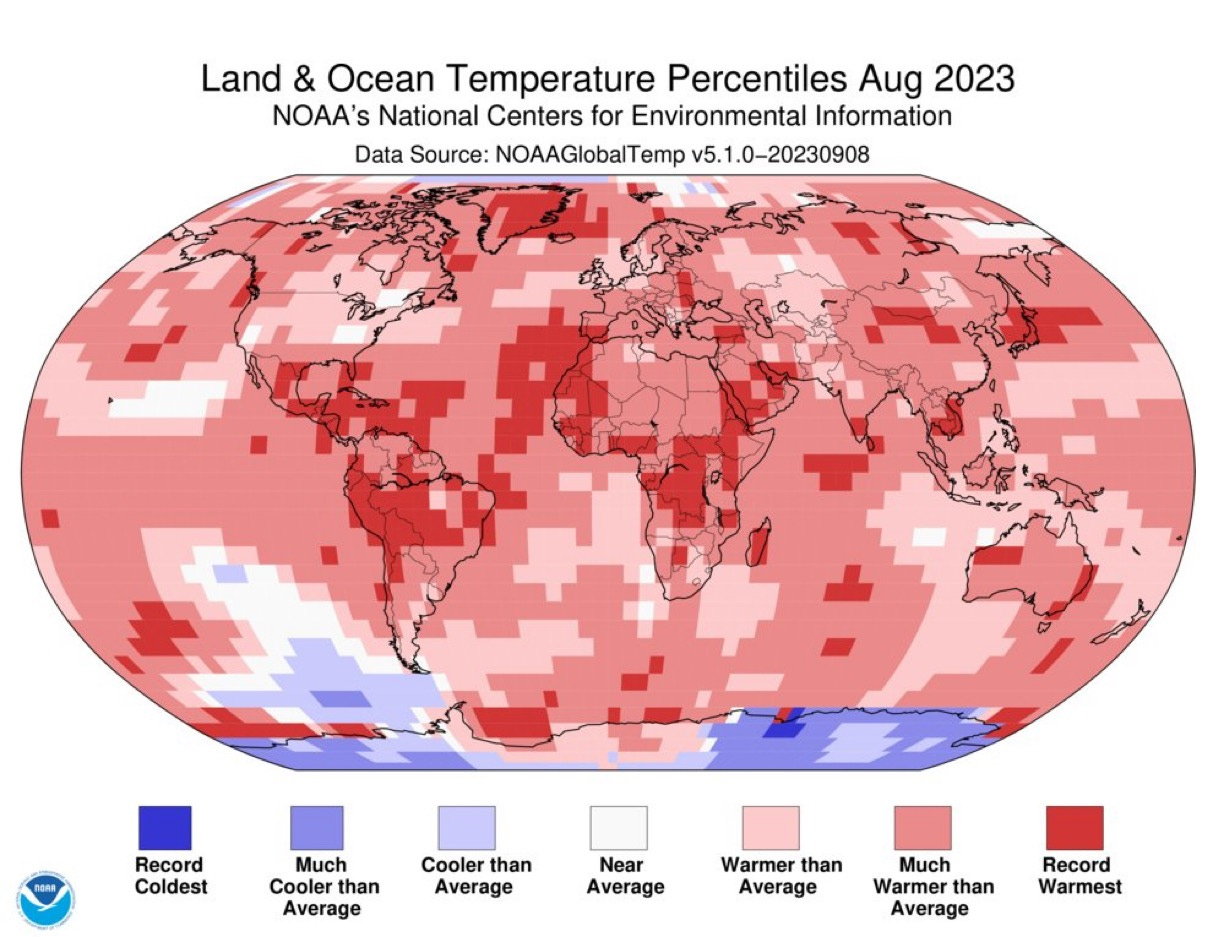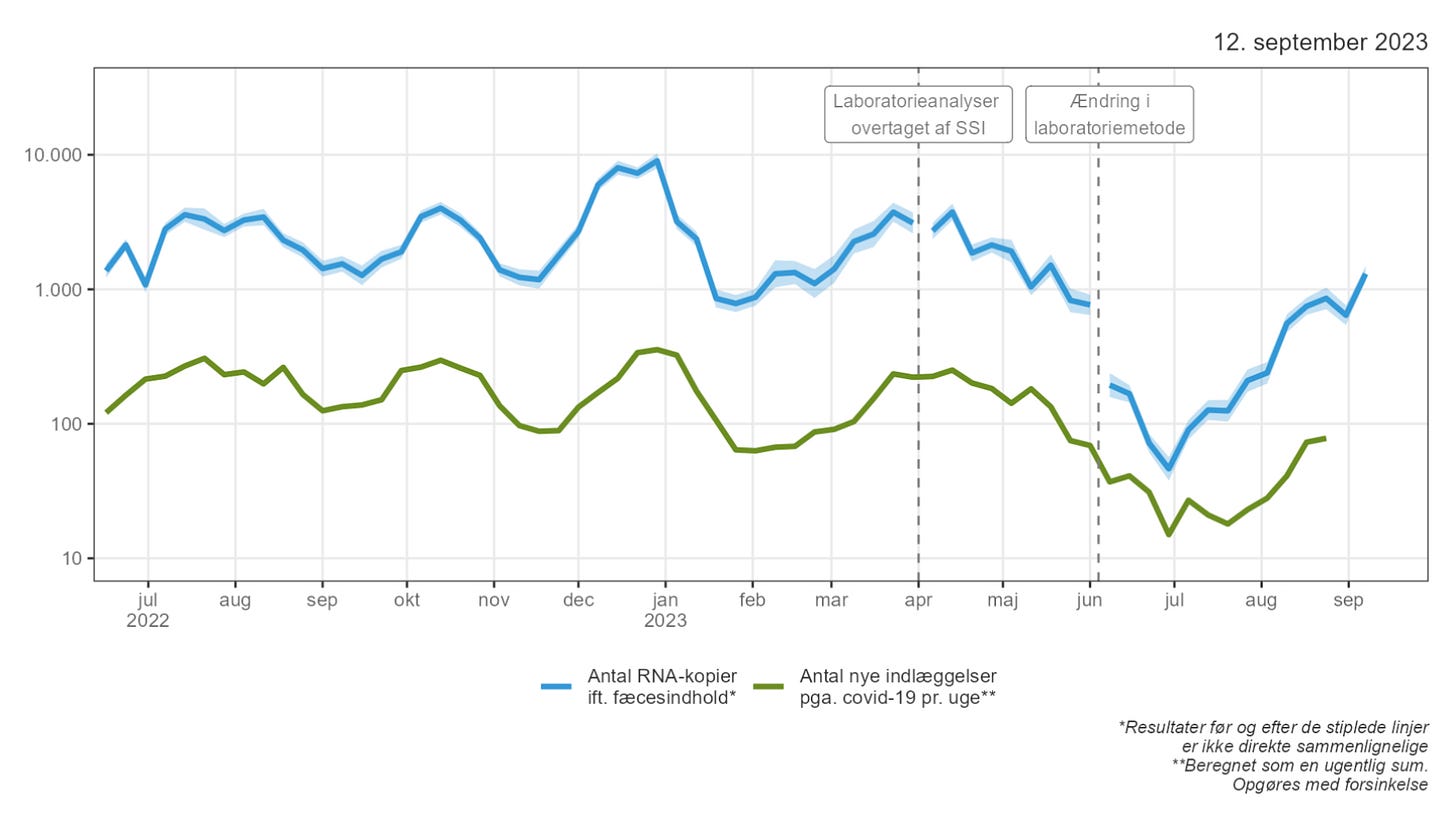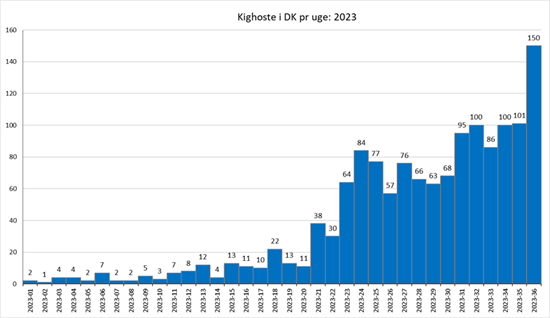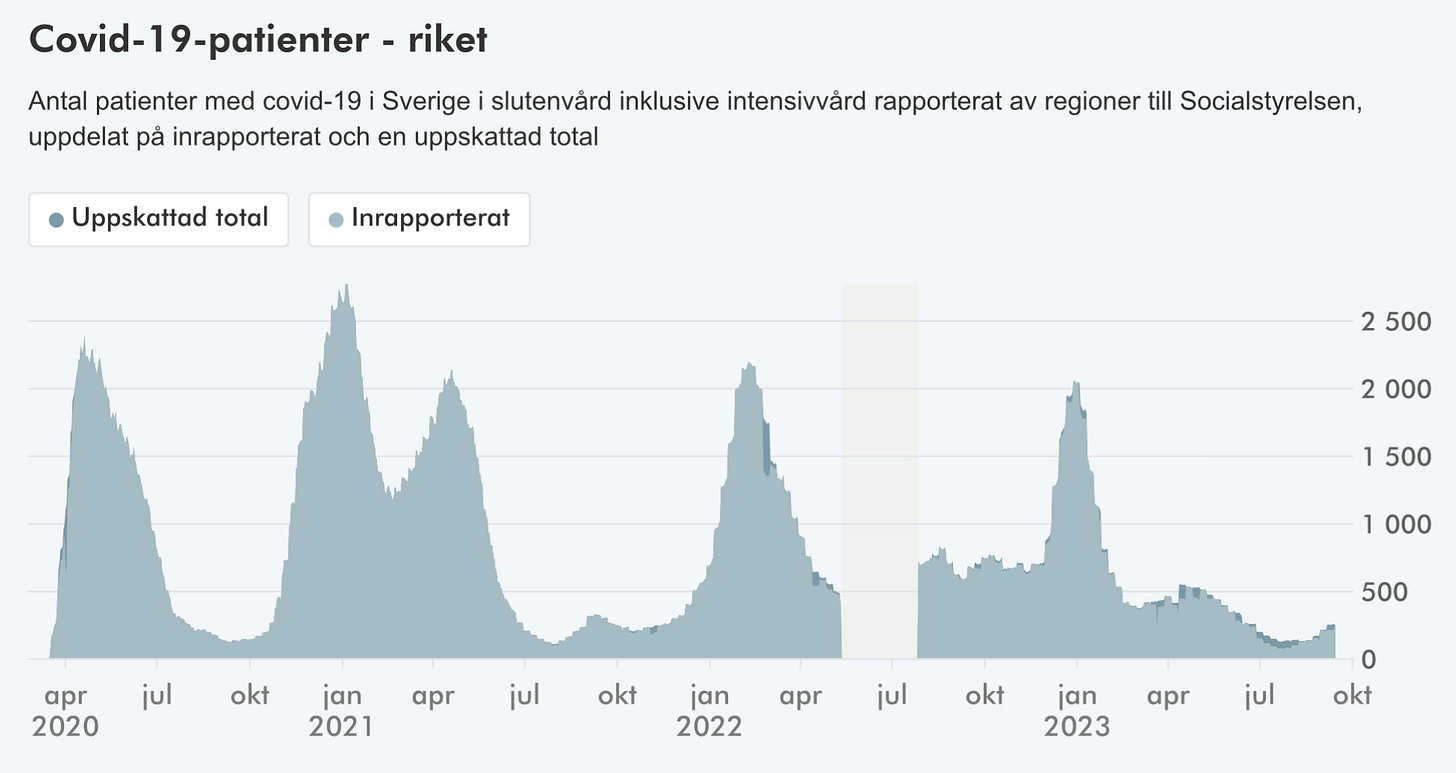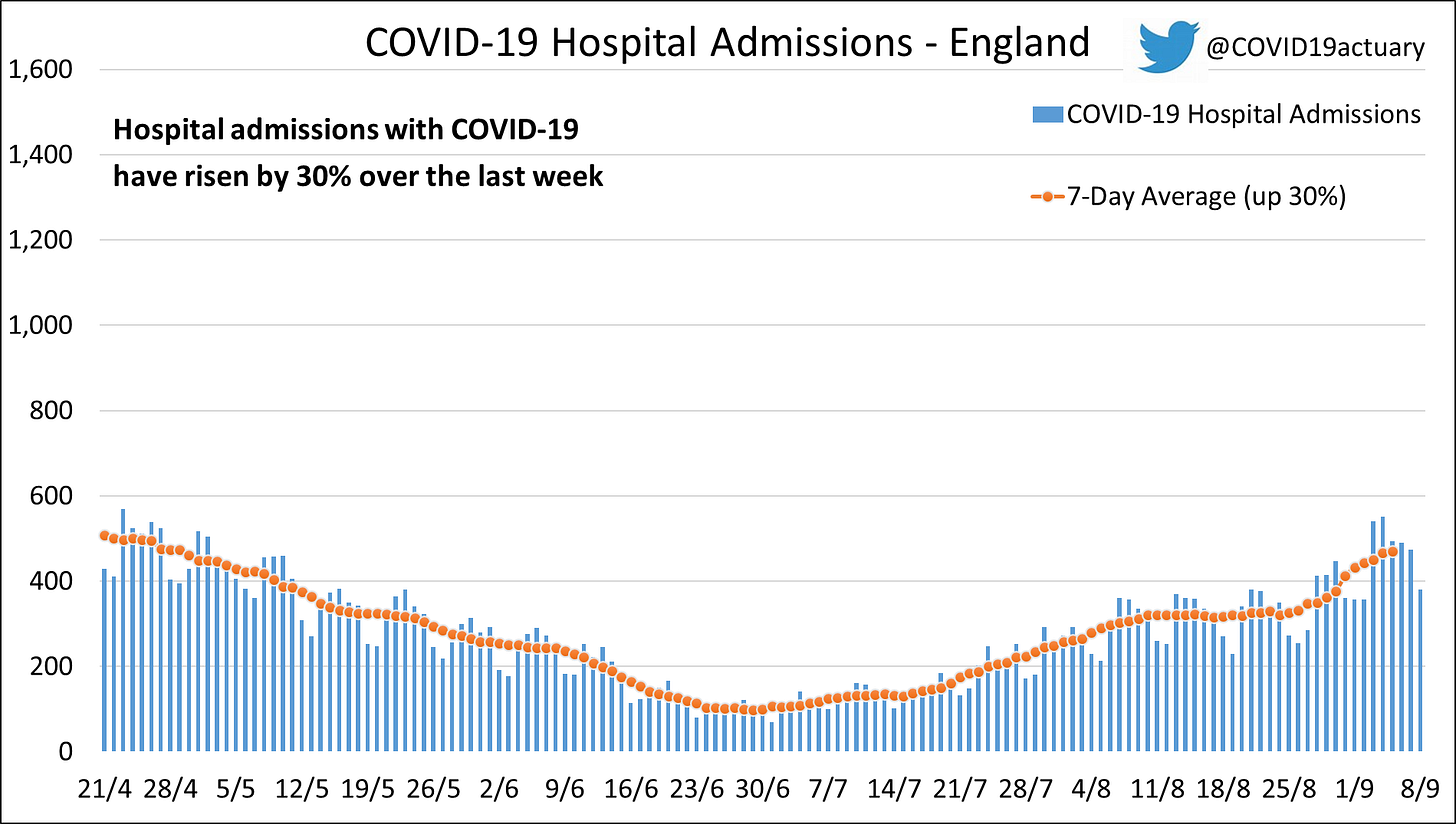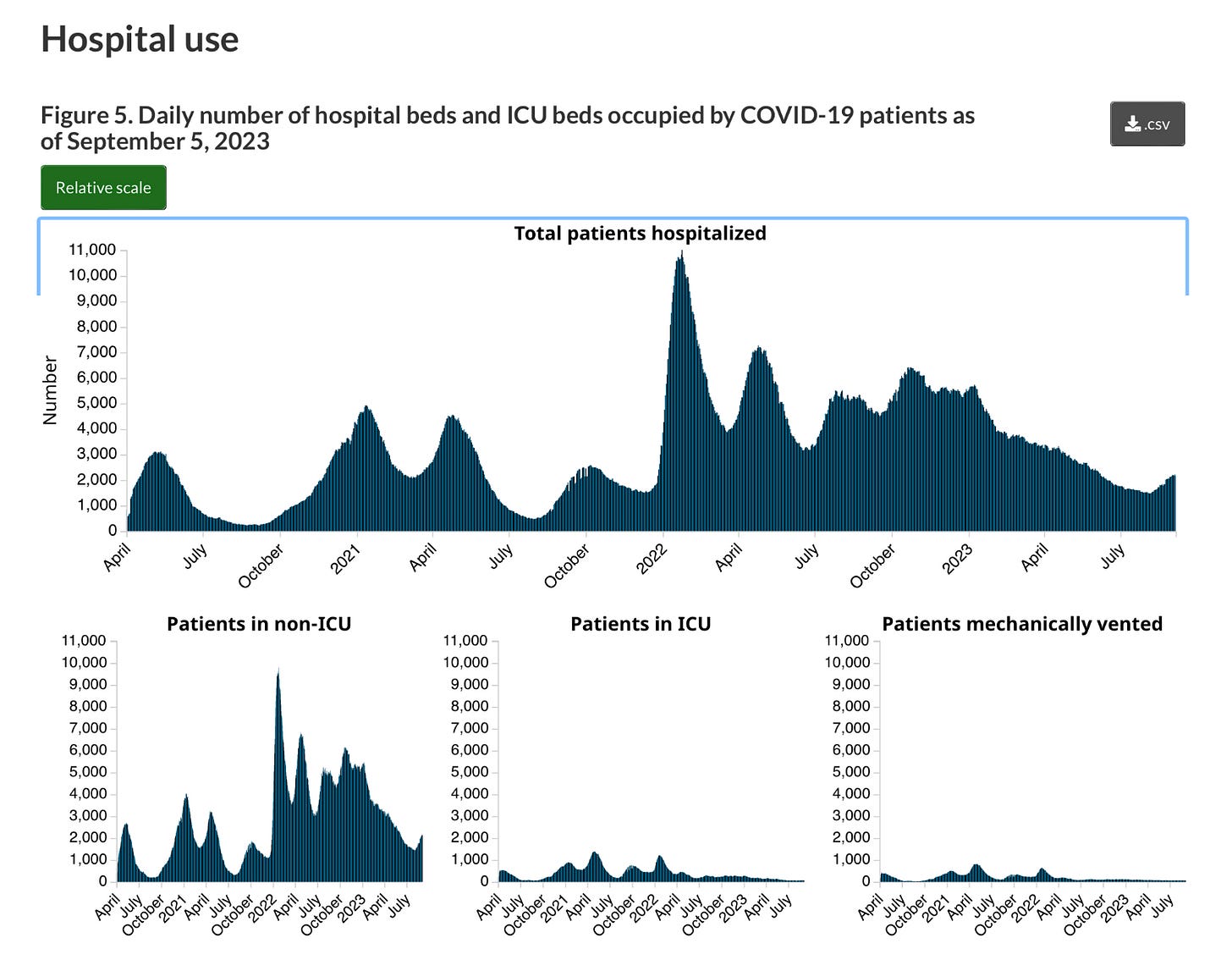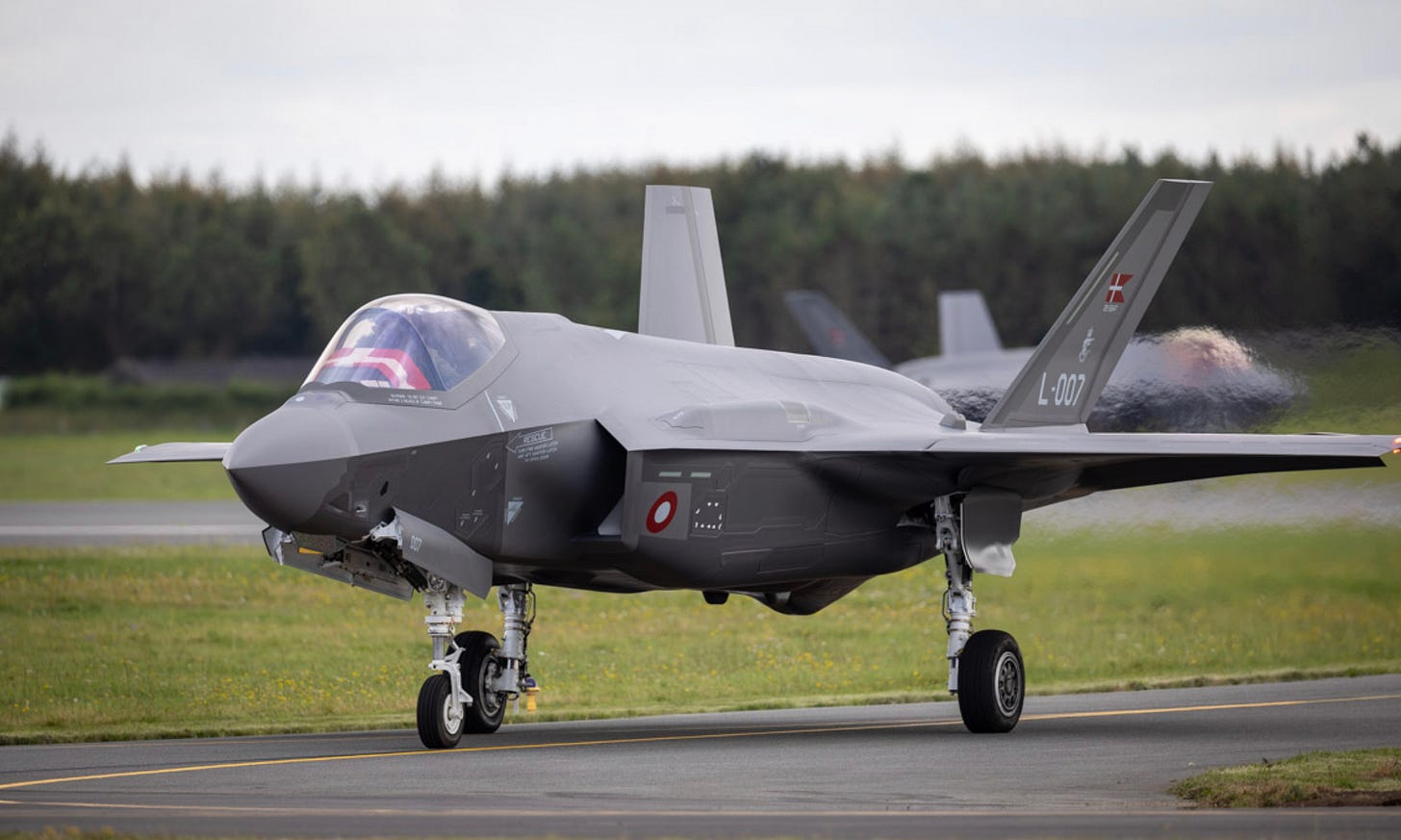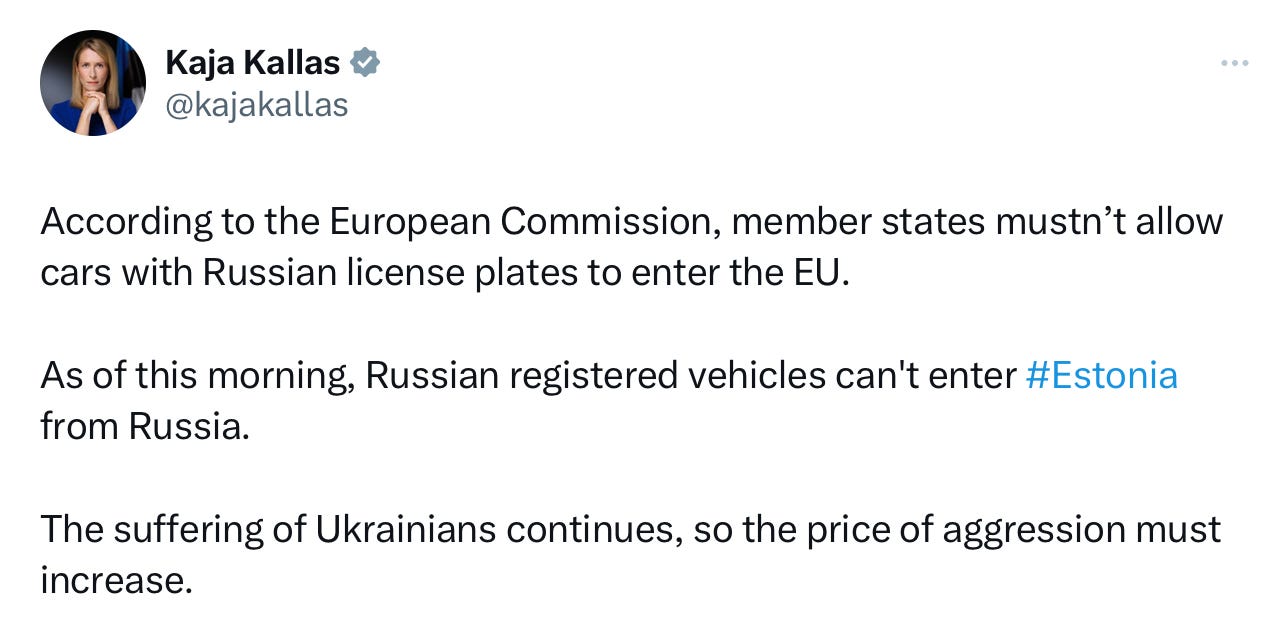The Evening Report - Sept 14
Our warming planet. COVID indicators rise. Historic day in Denmark.
🍃Environment & Energy⚡️
🌍
It is official August was the hottest month on Earth in the National Oceanic and Atmospheric Administration’s 174-year climate record. It also recorded the hottest summer on record in the Northern Hemisphere and the hottest winter on record in the Southern Hemisphere
NOAA Chief Scientist Dr. Sarah Kapnick:
“Not only was last month the warmest August on record by quite a lot, it was also the globe’s 45th-consecutive August and the 534th-consecutive month with temperatures above the 20th-century average. Global marine heat waves and a growing El Niño are driving additional warming this year, but as long as emissions continue driving a steady march of background warming, we expect further records to be broken in the years to come.”
Global sea surface temperatures also hit a record high last month and did so for the fifth consecutive month in a row. The monthly sea temperature in August was 1.03 degrees higher than normal.
The NOAA says sea ice coverage also hit a record low last month. There was about 550,000 square miles less sea ice than the previous record low set in August of 2019. Antarctica has had the lowest sea ice on record for four months running now.
-
A massive research effort has determined that humanity is stretching the limits of the earth’s ability to support human life. The team has been measuring humanity’s impacts on nine key “planetary limits” and found that six of them have been exceeded. The six are biodiversity destruction, the release of nitrogen, foreign chemicals exposure, reduction of global forest cover, stress on fresh-water resources, and climate change.
The three areas where limits have not yet been exceeded are depletion of the ozone layer, aerosol levels in the atmosphere, and acidification of the oceans. But the research team found while these limits haven’t been exceeded the burden is getting closer.
University of Copenhagen Professor of Biological Oceanography Katherine Richardson spoke to Dagbladet Information:
“It does not necessarily mean doomsday that six out of nine planetary boundaries have been exceeded, but it is a clear warning signal.”
In their report, the researchers conclude:
“The fact that six out of nine limits have been exceeded indicates that the Earth is now well outside the safe range for humanity.”
🇨🇦 🌍 🔥
The European Union’s Climate Change Service Copernicus says the number of wildfires around the globe has been higher than in years past. It does not provide a firm number. Canada has been one of the hardest hit nations suffering its worst wildfire season ever. Copernicus estimates Canadian wildfires accounted for 27% of all fire-related greenhouse gas emissions this year.
Senior Scientist Mark Parrington:
“As temperatures continue to rise and dry conditions become more long-term, the risk of devastating wildfires like those in Canada increases.”
🇩🇰
Weather records have fallen like dominos across Denmark this month. While the overall highest daily temperature record of 32.3 degrees set in September of 1906, remains in place a number of other weather records were broken.
According to the Danish Meteorological Agency, the highest temperature recorded so far this month was in Odense where it hit 28.5 degrees at H.C. Andersen Airport. That is the highest temperature in September ever recorded at Odense’s airport since measurements began to be recorded back in 1959. Odense wasn’t alone as regional records all over the country set new record highs in the first few weeks of the month.
A new national heat wave record was also set. DMI registers a heat wave as at least three consecutive days where temperatures exceed 25 degrees. In nine days from September 4th to the 12th, it was over 25 degrees somewhere in the country. This is the longest September heat wave in Denmark since 1874. It breaks the previous heat wave record of seven days set in September of 1999. Regionally heat wave records were also broken all over the country.
The scorching first half of September may also serve as Denmark’s last gasp of summer weather this year as the forecast calls for cooler temperatures and the return of rainy days as we begin the march into another winter.
-
Northern Jutland was hit by massive amounts of rain early this week. Several cloudbursts struck emptying roughly half a month’s worth of rain over the region in a matter of minutes. 15 to 30 millimeters of rain fell in just half an hour across North Jutland. Havnø, North of Rangers saw by far the heaviest rainfall with an eye-popping 50.8 millimeters of rain falling in just 30 minutes. For context, nationally Denmark usually sees about 74 millimeters of rainfall in the entire month of September.
The thunderstorm also unleashed a pretty viscous hailstorm in western Jutland where according to TV Midtvest some carport roofs, outbuildings, and even cars suffered damages.
-
Another sign of Denmark’s warming climate. The last two icebreakers owned by the Danish government will be decommissioned and scrapped this month. The icebreakers were used in years past to keep shipping lanes open around Denmark during the frigid winter months when ocean waters would freeze over. They were last used in the winter of 1995/96.
-
Beginning this week people who want to make the transition from oil, gas, or wood pellet boilers can apply for a 17,000 kroner grant to switch to a heat pump. To get the funds you must be a full-time resident of the home. The house also cannot be hooked up to a district heating system (Fjernvarme) or be in an area where Fjernvarme service will be expanded.
You can apply for the funding HERE.
-
People in Denmark will still be able to buy cheap beer and other beverages in German border stores without having to shell out for the deposit. The EU Court of Justice has rejected a ruling made the contrary in 2021. Danish groups had challenged the practice citing the loss of business to stores in Denmark and the environmental consequences because the cans might not be recycled and just end up in a landfill.
-
This is the way. A small bird called a Brushane in Danish (It is a Ruff in English) seems to be making a comeback on the island of Mandø after the species flirted with disappearing entirely. It has. We. 26 years since a female Brushane with chicks has been spotted on the island but this year that streak came to an end when three different mothers and their young were seen. Across the entire Wadden Sea, only five Brushane families have been seen since 1994. The Nature Foundation says that spotting the birds is a huge deal.
“It is a bit of a sensation because the Brushshane is one of our endangered and most discerning breeding meadow birds.”
The foundation credits the comeback on a determined effort to restore the bird’s habitat, which has included buying up and preserving more nature lands. On the island of Mandø alone, 173 hectares have been purchased and protected. The restoration work has also been beneficial to other birds and wildlife.
🇫🇮
Finland has become a European leader when it comes to the use of heat pumps. The country has more heat pumps installed per capita than any other European nation according to the European Heat Pump Association. The agency says Finland boasts nearly 70 heat pumps per 1,000 households. Norway is a close second with 60 per thousand. Denmark, Sweden, Estonia, and France round out the top of the list while the United Kingdom, Germany, and Hungary sit at the bottom.
There were nearly 200,000 heat pumps sold in Finland in 2022, a more than 50% increase year over year. The heat pump rush was largely triggered by last year’s energy crisis. Finland also offers hefty grants, up to €4,000, to help people make the switch.
-
After electricity prices in Finland shot into the stratosphere a few weeks ago they have fallen dramatically since. The average electricity price had been hovering around one cent per kilowatt hour and even briefly dipped into negative territory last Sunday as supply exceeded demand. The price fluctuations are due to some supply hiccups followed by more favorable windy weather.
-
Electricity use in Finland is at its lowest point since the world ushered in the new millennium. Finnish Energy says electricity use has dropped by 8% year over year. The largest decline has been in the industrial sector where consumption is down 11% in just the last four months. While energy savings initiatives get some of the credit an overall decline in manufacturing has also helped.
Since the Olkiluoto 3 nuclear reactor came online along with a significant increase in offshore wind farms, Finland has generated more electricity than it needs. However its efforts to export electricity have been hampered by chronic problems with the power grid in Sweden.
-
The Finnish Consumer Disputes Board has ruled that fixed-term electricity contracts must be adjusted if they are over 15% higher than average prices. But Finland’s national broadcaster Yle is reporting that electricity suppliers are going to ignore the recommendation. The board’s recommendations are not legally binding and with no enforcement teeth, power companies are not obligated to follow them.
🦠COVID🦠
🇩🇰
After coronavirus activity seemed to be stabilizing across Denmark, this week’s COVID wastewater surveillance is indicating that virus activity (blue line) is again increasing.
Weekly COVID hospitalizations (green line) also increased albeit just slightly.
-
The Statens Serum Institute phrased it as a “slightly increasing spread of infection” over the past week. The institute notes that positivity percentage, wastewater activity, new hospitalizations, and even virus deaths are all increasing. It notes that while infection-related admissions are rising, overall levels are lower than at this point last year.
-
Denmark’s fall and winter COVID vaccine booster dose campaign is now underway. Beginning today invitations to book a vaccination appointment will begin being sent out to those eligible. They should begin landing in people”s digital mailboxes fairly quickly.
Once you have received your invitation, you can book an appointment at vacciner.dk. Appointments can be booked between October 1 to January 15.
Anyone in a high-risk population and all seniors over 65 can also get a flu shot at the same time.
Chief Physician Kirstine Moll Harboe:
"If you are 65 years of age or older, or a younger person at increased risk, both COVID and influenza can cause a severe infection and, in the worst case, be life-threatening. That is why it is important to be vaccinated.”
Special pediatric influenza nasal spray vaccinations are also available for children two to six years old. Invitations to book an appointment will be sent to their parents by digital post beginning next week.
“The influenza vaccine for children is a very effective and safe vaccine, and unlike many other vaccines, is given as a nasal spray with a puff in each nostril. If you have children between two and six years of age, you will be offered vaccination. Therefore, keep an eye on your e-boks and book an appointment for your child.”
Just a reminder for people under the age of 65 who are in high-risk of vulnerable populations you will have to book your own vaccination appointment. There will be no digital invitations. Appointment bookings for this group begin on September 20 via www.vacciner.dk.
High-risk groups include:
People with chronic lung diseases
People with cardiovascular diseases
People with diabetes 1 or 2
People with congenital or acquired immunodeficiency. Including those being treated for cancer
People with respiratory issues
People with chronic liver or kidney disease
People with other chronic diseases making them a high-risk including serious rheumatological and neurological diseases.
People who are severely overweight (BMI>35)
People with severe mental illness and Down’s syndrome
Pregnant women in the 2nd or 3rd trimester
Also included is anyone who is living in the same household with anyone who meets the criteria above.
Outside of that the rest of the population will have to fend for itself. The Danish Health Authority is reminding people to manage their infection risk and follow the recommendations.
Stay home if you are sick
Ventilate indoor spaces
Wash your hands and use hand sanitizer
Cough and sneeze into your sleeve or elbow
And regularly clean commonly touched surfaces.
-
Denmark’s hospital system continues to struggle with a backlog of procedures and surgeries built up over the COVID pandemic and exacerbated by last year’s big nurses’s strike. According to the Danish Regions, the number of patients who have been referred to private hospitals and clinics for treatment has hit a new record high for a third straight year. In the first eight months of the year, 169,724 people have been sent to private facilities for care. That is already a 12% increase from last year’s record-high numbers and it is on pace to hit a 75% increase from 2019, the last full year before COVID arrived.
The Danish government has poured billions of kroner into the system to try and right the ship.
-
A whooping cough epidemic continues to sweep across Denmark. The Statens Serum Institute says there were another 150 cases just last week. Over 400 cases were recorded in August alone. Numbers like these haven’t been seen since the last whooping cough epidemic in 2020. The SSI says three of the cases last week involved infants less than a year old.
The SSI has begun offering vaccinations against whooping cough (pertussis), especially for pregnant women in the 2nd and 3rd trimester. The vaccine is part of the childhood inoculation program and is usually administered when a child is at least three months old.
🇸🇪
COVID hospitalizations (240) continue to climb in Sweden (+24) while the number of severely infected people in an ICU (5) treads water week to week.
-
One of the world’s largest efforts to find a medication to treat people suffering from long-COVID is underway in Sweden. The Karolinska University Hospital in Stockholm has involved 400 study participants who are struggling with severe long-COVID symptoms. They will be given a medication or a placebo in 15-day cycles and then tested extensively. The goal is to find a medication that can actually cure the disease instead of just treating some of its symptoms.
The World Health Organization estimates there could be about 36 million people suffering from long-COVID in Europe alone.
🇫🇮
The EG.5 variant has taken over in Finland. The Finnish Institute for Health says the strain and its sub-variants account for about 95% of what positive tests are still being sequenced. The variant also accounts for over 50% of wastewater surveillance testing.
The institute says while virus activity measured in wastewater surveillance has begun to increase this month the coronavirus epidemic in Finland is “calm.” That said, it warns the XBB variants do have an increased ability to evade immunity from a prior infection or vaccination. But it also stresses that the EG.5 variant, an XBB sub-strain, has not proven to cause any more of a severe infection than any of the other circulating variants.
The agency adds that, so far, there have not been any cases of the new BA.2.86 variant in Finland.
Specialist Researcher Erika Lindh:
"It is likely that it will also be observed in Finland sometime during the fall. However, it is still difficult to assess its spread. Since the number of coronavirus samples that are tested is relatively small both in Finland and elsewhere in the world, it takes longer to detect mutations.. The number of cases must be quite large before conclusions can be drawn about the epidemiological significance of a single mutation or the severity of the disease it causes.”
🇳🇴
During the first two years of the pandemic, ADHD diagnoses in Norway have increased. This is according to a new study from the Norwegian Institute of Public Health which notes that cases have risen for both genders.
Institute Director of Children’s Health and Development Heidi Aase says there could be several reasons for the increase.
“One possible explanation is that ADHD symptoms became more visible to the family when the children spent more time at home. It could also be that home school in front of a screen became particularly challenging for children with ADHD. Those who have coped well with the routines and help they have received at school may have had problems when those supports and frameworks disappeared.”
The NIPH says the increase in ADHD cases was particularly high among women 12 to 24 years old. While cases steadily increased among men, diagnosis numbers for women doubled from 2020 to 2022.
“It may be that many girls and young women have "gone under the radar" because they do not have the same symptoms of ADHD as boys. Knowledge about ADHD in girls is increasing, and this may also have contributed to more girls now receiving the diagnosis than before.”
Overall, the institute has noted a general increase in mental health issues and disorders during the COVID pandemic especially among the 12 to 24-year-old age group. Chief among them was a sharp increase in eating disorders among girls in that age group.
Senior Researcher Lasse Bang:
“We do not know the reasons for the increase, but it is possible that the loss of routines and "an ordinary everyday life" has had a particularly negative impact on symptoms of eating disorders. When society shut down there may have been fewer positive distractions, which may have led to a greater focus on one's own body, eating, and exercise.”
🇩🇪
The new BA.2.86 coronavirus variant continues to spread. Germany has confirmed its first infection due to the new strain. The Robert Koch Institute said a positive test result came back positive for the variant in the last week of August. Like other countries, COVID cases have been increasing in Germany.
🇪🇺💉
And then there were two. The European Medicines Agency has recommended that Moderna’s XBB variant-specific vaccine be approved for use in Europe. The recommendation will now go to the EU Commission for a final decision. This is usually a quick rubber-stamp.
The EMA is recommending that Moderna’s bivalent vaccine be used as a single dose for everyone over the age of five. Infants and young children up to four years old can get one or two doses depending if they have been previously vaccinated or not.
The EMA says it poured over all available data and determined the new vaccine formula triggered a strong immune response against XBB variants and other coronavirus strains.
The EU Commission has already approved the Pfizer/BioNTech XBB variant-specific vaccine for use in Europe.
🇬🇧
Infection-related hospitalizations in England have jumped by 30% from week to week according to the COVID Actuaries Response Group. The increase was seen across all regions of the country including a 41% jump in admissions in hospitals in London.
Intensive care occupancy also rose by 15%.
The reinfection rate, or R0, has increased to 1.16. Anything over one indicates degrees of a spreading epidemic.
🇯🇵
A fairly significant COVID wave has arrived in Japan. Health officials say they are seeing the number of infection-related hospitalizations reach levels not seen since last May. The country’s health minister warned people in a live address that the peak of the infection wave hasn’t arrived yet.
🇺🇸
In the last week, the coronavirus has claimed at least 123 more American lives. With over 1.1 million pandemic deaths and counting, so far, the virus has killed more Americans in the last three and half years than been killed in every war fought by the United States since 1775. There have been about 651,000 American war casualties.
🇨🇦
Health Canada has approved Moderna’s XBB variant-specific vaccine for use in the fall and winter booster dose campaign.
Chief Medical Advisor Dr. Supriya Sharma:
“The vaccine was authorized after an independent and thorough scientific review for safety, efficacy, and quality, and this included a review of data from several studies of the primary series of booster doses of the Spikevax vaccine collected over the last two years.”
The agency says preliminary data indicates the XBB-specific booster dose triggers a strong immune response against new variants like BA.2.86 and the EG.5 strain, which is currently dominant in Canada.
Canada’s health agency is recommending one booster dose of the new bivalent vaccine for everyone over the age of five. And one dose for previously vaccinated infants six months to four years old and two shots for infants who haven’t had a COVID vaccine yet.
Health Canada continues to review Pfizer/BioNTech’s new XBB-specific vaccine formula and is also assessing another vaccine candidate from Novavax.
-
Infection activity continues to increase across Canada and COVID hospitalizations continue to rise as well. In the week ending September 5, the total number of beds occupied by a coronavirus patient rose to 2,165, which is 40 more beds in use than the week before. General admissions rose by 36 to 2,100. There were 65 infected people needing intensive care, four more than the week previous. And there were 58 severely infected people needing a ventilator, an increase of one.
The positivity percentage also continues to climb and is now 15.1%.
🇺🇦/ 🇷🇺 War
🇩🇰 🇺🇦
Denmark has tabled its 12th and most expensive donation package to Ukraine yet. The package earmarks 5.8 billion Danish kroner (about $1.1 billion Cdn) for Ukraine over three years. The bulk of the money will be allocated this year with two smaller annual installments to come. The funds are to procure tanks, tank ammunition, infantry fighting vehicles, and anti-aircraft guns for the Ukrainian army.
The Danish legislative Finance Committee must still approve the funding.
Defense Minister Troels Lund Poulsen:
“It is absolutely crucial, so that Ukraine can continue to defend itself against Russia's illegal invasion, and that countries like Denmark maintain its military and financial support for Ukraine. We are now doing this with the largest Danish financial contribution to date.”
Foreign Affairs Minister Lars Løkke Rasmussen notes the change from donating actual weapons to money that will instead be used to procure them.
“With today's donation package, we are moving into a new phase. After more than a year and a half of war, we have come close to emptying our military stocks. That is why we are now looking into more targeted joint procurement and international collaborations, which are tailored to Ukraine's immediate needs.”
🇩🇰
Denmark has officially begun the transition from its fleet of aging F-16 fighter jets to the next generation F-35. On Thursday afternoon four Danish F-35s touched down at Skydstrup Air Force base after a two-day journey from Arizona where Danish pilots had been training on the plane.
The Danish Armed Forces called it a historic day for the country.
“The F-35 is more than just a fighter jet. The F-35 is a sensor platform that can lift the Danish combat power into a completely new league - both in the air, but also on the ground with the Army and at sea with the Navy, so that everyone can benefit from the aircraft's information and get an unprecedented overview over the battlefield.”
Denmark has purchased 27 F-35s so far. It plans to fully transition to the new jet by 2027 despite delivery delays already announced by Lockheed Martin.
🇩🇰/ 🇷🇺
Russia’s deputy health minister Oleg Salagaj was refused entry into Denmark this week. That is according to the Russian Embassy in Copenhagen. Salagaj flew into Copenhagen to attend a World Health Organization event being hosted in the Danish capital when he was refused entry into the country.
Tensions have been rising between Denmark and Russia as both countries have engaged in tit-for-tat expulsions of diplomatic staff. The Danish government recently capped staff at the Russian embassy in Copenhagen to no more than ten people.
-
Russian hackers succeeded in taking down websites belonging to the Danish Data Protection Agency and some other public agencies this week. The DDoS attack, where a website is overwhelmed with a wave of requests forcing it offline, happened on Tuesday. The Russian hacking group NoName057(16) is the likely culprit according to the data protection authority. While websites were taken down for a short time for the most part they were back online after a couple of hours.
🇪🇺🇸🇪/ 🇹🇷
It is a swing and a miss in Turkey’s efforts to use Sweden’s NATO application as a means to get into the European Union. In a new report, the EU states that Turkey is not even close to meeting the requirements for membership in the bloc. It also stresses that the process of joining NATO is entirely separate from joining the EU.
EU Parliamentarian Nacho Sánchez Amor:
“We have recently seen a renewed interest from the Turkish government in reviving the EU accession process. This will not happen because of geopolitical negotiations, but only when the Turkish authorities show genuine interest in stopping the continuous decline in fundamental freedoms and the rule of law in the country. Our message is clear: if Turkey wants to revive the EU accession process, we need clear, concrete actions, not words!”
The report notes that Turkey’s compliance with the EU’s common foreign and security policy as well as the bloc’s democratic values, all compulsory requirements of becoming a member state, have fallen to historic lows.
Turkish President Recep Tayyip Erdoğan has once again reversed course after promising to support Sweden’s NATO application and is now trying to leverage Turkish support for Sweden to gain entry into the EU.
🇭🇺/ 🇸🇪
What a difference a few months make. Rewind the clock and you have Turkey again promising to support Sweden’s NATO application and Hungarian Prime Minister Viktor Orbán again pledging his parliament’s support. Fast forward to today and Turkey has stayed true to form and gone back on its deal and Hungary is following suit. Hungarian Foreign Affairs Minister Péter Szijjártó fired off an incendiary letter to his Swedish counterpart and posted it on Twitter. He is accusing Sweden’s media and school curriculum of smearing Hungary’s democracy while trying to gain its support for joining NATO. This is the last paragraph.
“I am pretty sure you understand the contradiction between the two phenomena: you urge our Parliamentarians to ratify your accession to NATO, while you continue to accuse them as if they had destructed democracy in Hungary. This contradiction became now even stronger and definitely does not help your continuously raised demand to be fulfilled. I hope You will take this seriously into consideration - finally.”
Last year, the European Parliament voted to downgrade Hungary as “no longer a fully functioning democracy.” Instead, parliamentarians said Hungary should be considered a "hybrid regime of electoral autocracy" in which elections are regularly held but without respecting basic democratic norms.
“There is increasing consensus among experts that Hungary is no longer a democracy.”
This is a potentially concerning development for Hungary as having a fully functioning democracy and respecting the rule of law are requirements for being a European Union member.
Hungary and Turkey remain the only two of the 31 NATO member states that have yet to ratify Sweden’s NATO application.
🇸🇪 🇺🇦
Citing sources, Radio Sweden reported that the Swedish government is taking a serious look at sending JAS Gripen fighter jets to Ukraine. It has ordered the military to assess on how many planes could be transferred, how fast new ones could be manufactured, and what the impacts might be on Sweden’s defensive capabilities. According to the media outlet, this assessment must be finished by November and then the government will have to make a decision.
It won’t be an easy decision as there are a number of obstacles. First and foremost Ukrainian pilots and ground crew would have to be trained on the Gripen planes. Also because the fighter jets have a lot of American components the United States would have to sign off on the transfer. Finally, Sweden’s status as a NATO member nation, or not, will also factor in.
🇱🇹 🇪🇪🇪🇺/ 🇷🇺
The European Commission is stepping up enforcement of an entry ban on all cars with Russian license plates. While the prohibition has been on the books for months as part of a bevy of sanctions levied on Russia the EU is now working to ensure member states are complying and that the restriction is uniform across countries bordering Russia.
The ban applies to all private and commercial vehicles having a Russian license plate or that are registered in Russia.
The restriction also covers a big list of assorted personal products that Russians might try to bring across. This covers everything from dental floss and razor blades to items with potential military use like radio systems or electric generators.
The Baltic states, which continue to take a no-nonsense hard-line approach to Russia, are already acting. Lithuania isn’t just refusing to let cars from Russia cross the border but it also plans to seize any Russian cars that it finds on its roads.
Estonia looks to be following suit.
🇪🇪 🇱🇻/ 🇧🇾
Estonian Prime Minister Kaja Kallas says that a team of police and border guards from Estonia has been dispatched to neighbouring Latvia.
“Latvia has asked our help to counter the ongoing hybrid activities from Belarus. We offer our help to protect the EU external border and stand shoulder to shoulder with our neighbours.”
🇷🇴 🇺🇦/ 🇷🇺
Romania has expanded a flight restriction corridor along its border with Ukraine after Russian strikes on Ukraine’s ports in the Danube appear to have crossed the Romanian border. The flight restrictions now cover a corridor that extends to 4,000 meters in elevation with a depth of 20 to 30 kilometers of Romanian air space along the border depending on the border configuration. Only state aircraft and planes declaring an emergency are permitted to fly in the now restricted airspace. Any other aircraft will be met by responding Romanian air patrols.
🇸🇰/ 🇷🇺
Slovakia has expelled another Russian diplomat. The Slovakian Foreign Affairs Ministry says the activities of the embassy employee “grossly violated the Vienna Convention on Diplomatic Relations, which was carefully documented by the competent authorities of the Slovak Republic.”
Russia has pledged to respond in kind.
🇫🇮
Finnish Border Guards have begun patrolling along a three-kilometer fence along the Russian border. The fence is a pilot project to build fencing along some 200 kilometers of Finland’s 1,300 km border with Russia. Finland is looking to guard against illegal crossings and hybrid interference efforts that are ongoing between Belarus and bordering EU countries. Work on the next section of fencing is already underway.
-
For the first time, NATO deployed a surveillance drone over Finland this week. The RQ-4D drone. The drone conducted surveillance and operators familiarized themselves with the terrain of the newest member of the military alliance.
🇺🇦/ 🇷🇺
This won’t make any headlines but it is an extremely significant development. Ukraine has succeeded in transitioning one of its nuclear reactors from Russian nuclear fuel to fuel produced in the West. It is a major step for Ukraine’s energy security and a significant milestone in its move to align itself with the European Union and Western nations.
Odds & Ends
🇩🇰
Tick tick no baby boom. The Danish Region’s forecast that the number of babies born in Denmark in 2022 would be well over 70,000. Instead, there were 57,291 births last year, which is 8% fewer than the year before. It also marks the lowest birth rate in Denmark since 2014. The birth rate decline is fairly equally distributed across the country.
🇵🇹
A town in Portugal found itself awash in red wine this week. Several huge tanks at a distillery in São Lourenço do Bairro burst on Sunday sending 2.2 million liters of red wine flooding down the streets. That is about enough wine to fill an Olympic-sized swimming pool. It caused quite a mess but other than a major clean up there wasn’t much damage.




